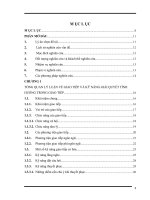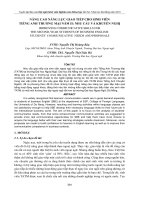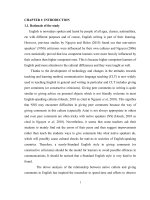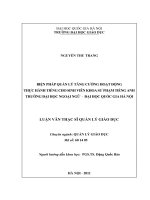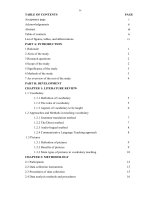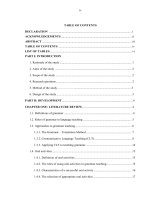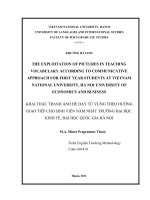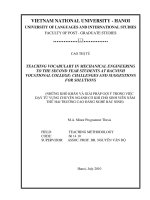Khai thác tranh ảnh để dạy từ vựng theo hướng giao tiếp cho sinh viên năm nhất trường Đại học Kinh tế, Đại học Quốc gia Hà Nội tt.PDF
Bạn đang xem bản rút gọn của tài liệu. Xem và tải ngay bản đầy đủ của tài liệu tại đây (780.48 KB, 14 trang )
VIETNAM NATIONAL UNIVERSITY, HANOI
UNIVERSITY OF LANGUAGES AND INTERNATIONAL STUDIES
FACULTY OF POST-GRADUATE STUDIES
***
KHƯƠNG HÀ LINH
THE EXPLOITATION OF PICTURES IN TEACHING
VOCABULARY ACCORDING TO COMMUNICATIVE
APPROACH FOR FIRST YEAR STUDENTS AT VIETNAM
NATIONAL UNIVERSITY, HA NOI UNIVERSITY OF
ECONOMICS AND BUSINESS
KHAI THÁC TRANH ẢNH ĐỂ DẠY TỪ VỰNG THEO HƯỚNG
GIAO TIẾP CHO SINH VIÊN NĂM NHẤT TRƯỜNG ĐẠI HỌC
KINH TẾ, ĐẠI HỌC QUỐC GIA HÀ NỘI
M.A. Minor Programme Thesis
Field: English Teaching Methodology
Code: 601410
Hanoi, 2011
VIETNAM NATIONAL UNIVERSITY, HANOI
UNIVERSITY OF LANGUAGES AND INTERNATIONAL STUDIES
FACULTY OF POST-GRADUATE STUDIES
***
KHƯƠNG HÀ LINH
THE EXPLOITATION OF PICTURES IN TEACHING
VOCABULARY ACCORDING TO COMMUNICATIVE
APPROACH FOR FIRST YEAR STUDENTS AT VIETNAM
NATIONAL UNIVERSITY, HA NOI UNIVERSITY OF
ECONOMICS AND BUSINESS
KHAI THÁC TRANH ẢNH ĐỂ DẠY TỪ VỰNG THEO HƯỚNG GIAO
TIẾP CHO SINH VIÊN NĂM NHẤT TRƯỜNG ĐẠI HỌC KINH TẾ, ĐẠI
HỌC QUỐC GIA HÀ NỘI
M.A. Minor Programme Thesis
Field: English Teaching Methodology
Code: 601410
Supervisor: Đỗ Bá Quý, M.A.
Hanoi, 2011
iv
TABLE OF CONTENTS PAGE
Acceptance page i
Acknowledgements ii
Abstract iii
Table of contents iv
List of figures, tables, and abbreviations vi
PART A: INTRODUCTION
1 Rationale 1
2 Aims of the study 2
3 Research questions 2
4 Scope of the study 2
5 Significance of the study 3
6 Methods of the study 3
7 An overview of the rest of the study 4
PART B: DEVELOPMENT
CHAPTER 1: LITERATURE REVIEW
1.1 Vocabulary
1.1.1 Definition of vocabulary 5
1.1.2 The roles of vocabulary 5
1.1.3 Aspects of vocabulary to be taught 6
1.2 Approaches and Methods in teaching vocabulary
1.2.1 Grammar translation method 7
1.2.2 The Direct method 7
1.2.3 Audio-lingual method 8
1.2.4 Communicative Language Teaching approach 8
1.3 Pictures
1.3.1 Definition of pictures 9
1.3.2 Benefits of pictures 9
1.3.3 Main types of pictures in vocabulary teaching 10
CHAPTER 2: METHODOLOGY
2.1 Participants 12
2.2 Data collection instruments 13
2.3 Procedures of data collection 15
2.4 Data analysis methods and procedures 16
v
CHAPTER 3: RESULTS AND DISCUSSION
3.1 The current exploitation of pictures to teach vocabulary 18
3.2 Advantages of using pictures 22
3.3 Main difficulties in using pictures to teach vocabulary 24
3.4 Desires and pedagogical suggestions 27
PART C: CONCLUSION
1 Conclusion 30
2 Pedagogical suggestions 32
3 Limitations of the study 33
4 Suggestions for further research 34
REFERENCES 36
APPENDICES
Appendix 1A: Contents of the course book New English File Elementary
Appendix 1K: Contents of the course book New English File Pre-intermediate
Appendix 1H, 1I, 1J, 1N: Samples of vocabulary bank from the course books
Appendix 1B, 1C, 1D, 1E, 1F, 1G, 1L, 1M, 1N, 1O, 1P, 1Q: Suggested worksheets
Appendix 2A, 2B: Questionnaires for teachers and students
Appendix 2C, 2D: Interviews for teachers and students
Appendix 3: Transcription of the Interviews
1
TÓM TẮT LUẬN VĂN
ABSTRACT
English has become the key role of in the world of communication and vocabulary
is seen as one of the most important elements of the language. Notably, the big question of
how to teach vocabulary in communicative approach effectively is categorically in
consideration. Therefore, this study aims to examine the current exploitation of pictures in
teaching vocabulary to first year students at Vietnam National University, Hanoi
University of Economics and Business. The advantages, hindrances, and the desires of this
technique perceived by teachers and students are also made clear. Data was collected by
means of interviews and questionnaires. Results showed that pictures were used to teach
vocabulary with remarkably high frequency. However, pictures exploited were mainly
from the course book. It is worth noting that almost all of teachers and students assumed a
great number of outstandingly strong points of this type of visual aid and desired to apply
pictures in teaching vocabulary. The findings emphasize all of these results and present
pedagogical suggestions from both surveyed teachers and students for further exploitations
of pictures. In addition, the researcher’s major recommendations are also listed out to
enhance the effectiveness of picture exploitation in teaching vocabulary.
PART A: INTRODUCTION
1 Rationale
2
Vocabulary, one of the major components of language, reserves a consideration in
both teaching and learning English.
In the context of Viet Nam National University, Hanoi University of Economics
and Business, English is being taught as a compulsory subject for non-major students. As
far as the situation of English language learning and teaching is concerned, students have
confronted a number of obstacles preventing them from achieving communicative
competence.
To overcome these disadvantages, the gap between classroom knowledge and
students’ ability in real communication should be bridged.
From the above mentioned reasons, this thesis on exploitation of pictures in
teaching vocabulary meets the research demand of the context.
2 Aims of the study
The research thesis is expected to find out whether pictures have been exploited, a
closer look would be taken at the different ways they are employed. Secondly, the study
aims at clarifying the fundamental advantages, disadvantages paving the ways for several
pedagogical implications for better employments of pictures in the context of teaching
vocabulary to first year students at VNU, HUEB.
3 Research questions
1. How have pictures been exploited by teachers in teaching English vocabulary for first
year students at Vietnam National University, Hanoi University of Economics and
Business?
2. What are the advantages of pictures in teaching vocabulary as perceived by teachers and
students?
3. What are the main difficulties in exploiting pictures in teaching vocabulary as
perceived by teachers and students?
4. Do teachers and students desire to use pictures in teaching vocabulary?
What are their suggestions for more exhaustible exploitation of pictures in teaching
vocabulary?
4 Scope of the study
The study is restricted to the area of investigating in the uses of pictures-one type of
visual aids in teaching vocabulary not a wide range of visual aids. The samples of the study
are also limited to only first year students from main stream classes at Vietnam National
University, Hanoi University of Economics and Business.
5 Significance of the study
3
As one of the trail-blazing studies on teaching vocabulary with the help of pictures
to freshmen at VNU, HUEB, the thesis could be particularly useful for students, teachers,
and researchers who develop an interest in the topic.
6 Methods of the study
6.1 Data collection methods
During the process of data collection, the researcher employed the questionnaires
and interviews.
6.2 Data analysis methods
In the first place, the collected data would be classified according to four research
questions. The needed combination of gathered responses from both teachers and students
was to analyze four research questions.
7 An overview of the rest of the study
The rest of the thesis includes five chapters
Chapter 1 (Literature review) provides the background of the study, including definitions
of key concepts and aspects of vocabulary.
Chapter 2 (Methodology) describes the participants and instruments of the study, as well as
the procedures employed to carry out the research.
Chapter 3 (Data analysis and discussion) presents, analyzes and discusses the collected
data from the questionnaires, interviews and class observations
Conclusion summarizes the main issues discussed in the thesis, the findings that the
researcher found out from the data collected according to the four research questions, the
limitations of the research, several pedagogical recommendations concerning the research
topic as well as some suggestions for further studies. Following this chapter are
bibliography and appendices.
PART B: DEVELOPMENT
CHAPTER 1: LITERATURE REVIEW
1.1 Vocabulary
1.1.1 Definition of vocabulary
It is worth noting that there are various definitions of vocabulary and each has its
own features reflecting some aspects of vocabulary.
1.1.2 The roles of vocabulary in language teaching and learning
4
It is widely accepted that vocabulary is the most important dimension of all
language materials.
1.1.3 Aspects of vocabulary to be taught
A matter of great concern for teachers is what aspects of a word should be taught in
a language class. To understand a text, learners need to know words and “knowing a word
involves knowing: its spoken and written context of use, its pattern with words of related
meaning, (Cater, 2001, p.43), (as cited in To Thu Huong et al, 2008, P.77).
1.2 Approaches and Methods in teaching vocabulary
1.2.1 Grammar translation method
According to Richards and Rodges (1996), “In the nineteenth century, the
Grammar Translation Method was the primary method used to teach English” (As cited in
To Thu Huong et al, 2008, p. 28).
1.2.3 Audio-lingual method
Because of weak points of previous methods in developing students’
communicative skills, a new pedagogical direction was needed and Audio-lingual method
naturally continued as a rule of development.
1.2.4 Communicative Language Teaching approach
In the late 1950s the Audiolingualism proved ineffective, and it began to fall out of
favor. Hymes (1772) added the concept of communicative competence, which emphasized
using language for the meaningful communication_ Communicative Language Teaching
(as cited in Nobert, S, 1997, p.34)
1.2.4.1 Features of Communicative Language teaching approach
Norbert Schmitt, (1997, p.14) pointed, “The focus is on the message and
fluency rather than grammatical accuracy.
1.2.4.2 Principles of teaching English vocabulary in CLT approach
The various pedagogical principles of CLT approach to language teaching in
general and vocabulary in particular are shown quite clearly. According to Hubbard et al
(1989) in Nation (2003) (as cited in To Thu Huong et al, 2006, p.91) general principles
could be summarized in the following main ones.
1.3 Pictures
1.3.1 Definition of pictures
Being one major type of visual aids, a picture, as defined in the Oxford Advanced
Learners’ Dictionary is “a visual representation or image painted, drawn, photographed, or
otherwise rendered on a flat surface
5
1.3.2 Benefits of pictures
Concerning the benefits of using pictures in teaching vocabulary, it is said that pictures are
“of great help in stimulating the learning of a foreign language” (Bowen, 1982, p.1).
1.3.3 Main types of pictures in vocabulary teaching
Picture Flashcards
Drawings
Wall pictures
CHAPTER 2: METHODOLOOGY
2.1 Participants
The process of data collection involved the participation of both English teachers
and first year students at VNU, HUEB.
2.2 Data collection instruments
2.2.1 Questionnaire
Two different sets of questionnaires were utilized, one for the teacher and the other
for first-year students.
2.2.2 Interviews
In terms of structures, the interviews with the teachers aimed at exploring specific
and typical types of pictures exploited by the interviewees.
2.3 Procedures of data collection
The data collection went through three major phases in chronological order: preparing
instruments, delivering questionnaires, and interviewing.
2.4 Data analysis methods and procedure
In the first step, the data collected was classified according to four research questions.
Since each research question aimed at exploring an aspect of using pictures to teach
vocabulary from teachers and students’ views, it must be answered through the synthesis of
information involving the two parties.
CHAPTER 3: RESULTS AND DISCUSSION
3.1 The current exploitation of pictures to teach vocabulary for first year students at
VNU, HUEB.
6
0 20 40 60 80 100 120
Teachers'answers
Students' answers
Yes
No
Figure 1: Using pictures to teach vocabulary according to teachers and students’
answers
3.1.1 The frequency of teachers using pictures in teaching vocabulary
18.2
36.4
9
36.4
never
rarely
s ometime
s
us ually
always
Figure 2: The frequency of using pictures to teach vocabulary
A) Students’ responses B) Teachers’ responses
3.1.2 Teachers’ ways to exploit pictures in teaching vocabulary
9.1
91.9
1
1
1
72.7
27.3
100
0
0
100
27.3
72.7
27.3
72.7
45.5
54.5
27.3
72.7
18.2
81.8
36.4
63.6
54.5
45.5
63.6
36.4
27.3
72.7
0%
10%
20%
30%
40%
50%
60%
70%
80%
90%
100%
1 2 3 4 5 6 7 8 9 10 11 12 13
No
Y es
`
Figure 3: Teachers’ ways to exploit pictures to teach vocabulary
F requenc y of us ing
pic tures
A
4.3
16.8
29.3
41.3
8.3
never
rarely
s ometimes
us ually
always
7
3.2 Advantages of using pictures to teach vocabulary perceived by teachers and
students
3.2.1 Teachers’ perception of the advantages of using pictures
Table 2: Advantages of using pictures in teaching vocabulary as perceived by
teachers
3.2.2 Students’ perception of advantages of using pictures
Statement
Perceived
by 120
students
Strongly
agree
(5pts)
Agree
(4 pts)
Neutral
(3pts)
Disagree
(2pts)
Strongly
disagree
(1pts)
On
Average
1
36
27
19
21
17
3.37
2
39
41
15
18
7
3.72
3
35
20
22
19
24
3.19
4
31
27
28
15
19
3.29
5
22
41
17
21
19
3.22
6
13
30
39
10
28
2.92
7
14
17
21
35
33
2.53
8
25
31
29
20
15
3.26
9
9
21
17
30
43
2.36
Statement
Perceived by
11 teachers
Strongly
agree
(5pts)
Agree
(4 pts)
Neutral
(3pts)
Disagree
(2pts)
Strongly
disagree
(1pts)
On
average
1
7
3
1
0
0
4.55
2
8
3
0
0
0
4.73
3
2
4
3
1
1
4.4
4
4
3
2
1
1
3.73
5
4
2
2
2
1
3.54
6
2
2
3
1
3
3.09
7
1
2
2
4
1
2.55
8
1
2
3
4
1
2.64
9
1
1
3
3
2
2.4
8
Table 3: Advantages of using pictures in teaching vocabulary as perceived by
students
3.3 Main difficulties in using pictures to teach vocabulary as perceived by teachers
and students
0%
10%
20%
30%
40%
50%
60%
70%
80%
90%
100%
1 2 3 4 5 6 7 8
strong ly
disa g re e
disa g re e
neutra l
a g re e
strong ly
a g re e
Figure 4: Difficulties in using pictures to teach vocabulary perceived by teachers
40.8
23.3
13.3
17.5
5.1
19.2
25.8
12.5
16.6
25.9
31.6
20.8
16.6
14.2
16.8
21.6
18.3
16.6
15
28.5
30.8
15
17.5
14.2
22.5
12.5
8.3
28.5
28.5
22.2
12.5
15.8
17.5
29.2
25
5.1
17.5
13.3
23.3
40.8
0%
20%
40%
60%
80%
100%
1 2 3 4 5 6 7 8
strongly
disagree
disagree
neutral
agree
strongly
agree
Figure 5: Difficulties in using pictures to teach vocabulary perceived by students
3.4 The desires and pedagogical suggestions for more exhaustible exploitation of
pictures
9
3.4.1 The desires for using pictures to teach vocabulary as perceived by teachers
and students
B
18.2%
45.4%
36.4%
Y es It depends No
Figure 6: Teachers and students’ attitudes towards the necessity of using pictures to
teach vocabulary
3.4.2 The pedagogical suggestions for more exhaustible exploitation of pictures
Firstly, reducing the number of students in one English class played a vital role in
raising the efficiency according to teachers’ points of view. Secondly, many teachers
complained that the time for teaching vocabulary was not much enough.Thirdly, the
improvement of the quantity, quality of pictorial materials and activities with the help of
pictures also needed more appropriate adaptation.
PART C: CONCLUSION
1 Conclusion
Initially, the study confirmed that pictures had been widely exploited in teaching
English vocabulary by English teachers at VNU,HUEB in the light of Communicative
Language Teaching Approach.
Secondly, the study also detected significant advantages and difficulties of the
exploitation of pictures in teaching vocabulary as perceived by both teachers and students.
Most of the participants showed their strong agreement on major strong points of using
pictures such as making vocabulary more enjoyable, drawing students’ attention,
enhancing motivation to learn, boosting students’ abilities to remember and use words for
communicative purposes and especially bringing images of the real life into the classroom.
A
20.5%
12.2%
67.3 %
Y es No It depends
10
Thirdly, main obstacles for further exploitation of pictures in teaching vocabulary
were also elaborated apparently. Among the detected hindrances, the problems of being
time-consuming for teachers to choose the suitable pictures and design effective exercises
was one of the most momentous ones as perceived by both teachers and students
Finally, it was considerable that there were strong desires of the exploitation of
pictures among all of the surveyed students.

